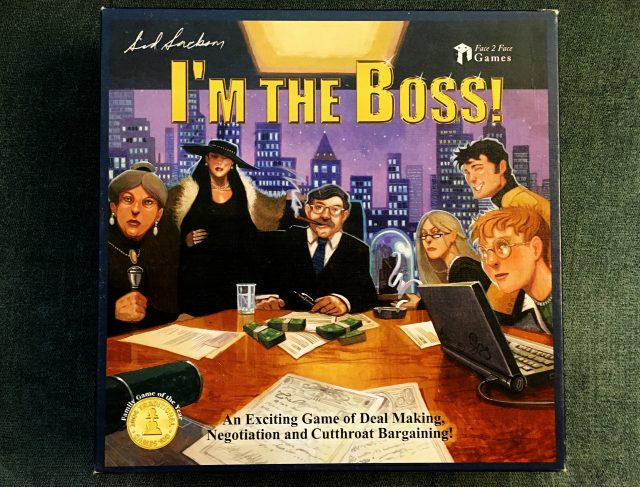In my last article I bemoaned the fact that many great older games have gotten left behind in what some people call “the cult of the new”. In that spirit, and to try to prove I’m not a hypocrite, I want to talk about one of my Top Ten games which has, I believe, stood the test of time. It currently sits at the 817th most-popular game on BGG (183rd in the Family sub-category). I’m hoping that I do a good enough job to get you to track down a copy and bring it to table. It’s still in print—and there’s a good reason for that. Because it’s a bloody great game.
But it might end some friendships. Fair warning.
 I’m The Boss was first published in 1994, and it was the brainchild of Sid Sackson, truly one of the greats of game design, responsible for such classics such as Acquire, Can’t Stop, and Sleuth. He deserves a retrospective of his own (note to self).
I’m The Boss was first published in 1994, and it was the brainchild of Sid Sackson, truly one of the greats of game design, responsible for such classics such as Acquire, Can’t Stop, and Sleuth. He deserves a retrospective of his own (note to self).
In I’m the Boss, you’re trying to prove you’re the ultimate Dealmaker. Starting with no money and some Influence cards, you and your opponents will dice your way around a Monopoly-looking board like sharks on a diet, making a series of increasingly-large Deals. Whoever has the most cash at the end is the winner.
Depending on the number of players, each player will be representing (not actually taking the role of—the distinction will be made clear later) one or two named Investors, in the form of Investor Cards. But don’t get too fond of your starting Investor(s); there is a high, high chance you’ll be leavin’ this rodeo with a different clown than the one you arrived with.
 Each space on the board represents a Deal worth a certain number of shares. The value of these shares comes from a stack of fifteen pre-stacked tiles. In Deal #1, each share is worth ((say it with me now in your best Doctor Evil voice)) “Two…million…dollars.” By the fifteenth Deal (if the game hasn’t ended yet) each share is worth five million large.
Each space on the board represents a Deal worth a certain number of shares. The value of these shares comes from a stack of fifteen pre-stacked tiles. In Deal #1, each share is worth ((say it with me now in your best Doctor Evil voice)) “Two…million…dollars.” By the fifteenth Deal (if the game hasn’t ended yet) each share is worth five million large.
BUT. To close each Deal certain Investors must participate. The bigger the Deal, the greater the number of Investors that must be involved. In some cases, those Investors are specified by name. In others, two from a list of three or three from a list of five or some other combination of Investors must be involved. In other words, you can almost never close a Deal all by yourself. You will need other players to cooperate with you. And the negotiations that arise out of those simple parameters are the meat of the game. Players can only negotiate using the money from the current deal—no prepayments, no bribes, no binding future promises.
However, I mentioned players begin with cards in hand. Those cards can, and will, be played (in real time, by any player in any order) while a Deal is in progress to do things like:
You can see why this is the game where friendships can go to die. I was in one game that ended abruptly (and with many naughty words) when one player insisted on closing Deals at a breakneck pace, effectively freezing out slower-moving players (which, although not technically against the rules, was a pretty shit move).
 When the game is played well, in its true spirit, Deals go down like episodes of The Wire, with plot twists, character development, sudden shifts in fortune, and bitter (albeit temporary) recrimination. As the game continues and the stakes get higher, and the tension ratchets up accordingly.
When the game is played well, in its true spirit, Deals go down like episodes of The Wire, with plot twists, character development, sudden shifts in fortune, and bitter (albeit temporary) recrimination. As the game continues and the stakes get higher, and the tension ratchets up accordingly.
Sackson, in his wisdom, made a canny decision when it came to the game-end trigger. After the tenth and each subsequent Deal, the Boss rolls a die to see if the just-completed Deal was, in fact, the last. This means you don’t know how many Deals the game will last, which makes it harder to pace yourself. You can’t just “wait out the clock” if you happen to win big in a particular round.
The latest edition of the game rules includes a bunch of variants and even a two-player version. I don’t know who came up with the variants (the latest edition came out after Sackson’s death), so I can’t vouch for them. The two-player rules seem to make the game more into a strategy-puzzly kind of game—which is fine, but it ain’t I’m The Boss. There’s also I’m The Boss: The Card Game, which is listed on BGG as being designed by Sid Sackson, but since the game came out ten years after Sackson’s death, I’m a little leery. It’s also apparently pretty good, but…it ain’t I’m The Boss. As far as negotiation games go, I’m The Boss is…well…The Boss.
[…] next year here)), I thought I’d continue my “you really should try” series (the first was back at the beginning of March) with Andreas Seyfarth’s Puerto Rico. We have here a game that sits at #11 on BGG’s overall […]